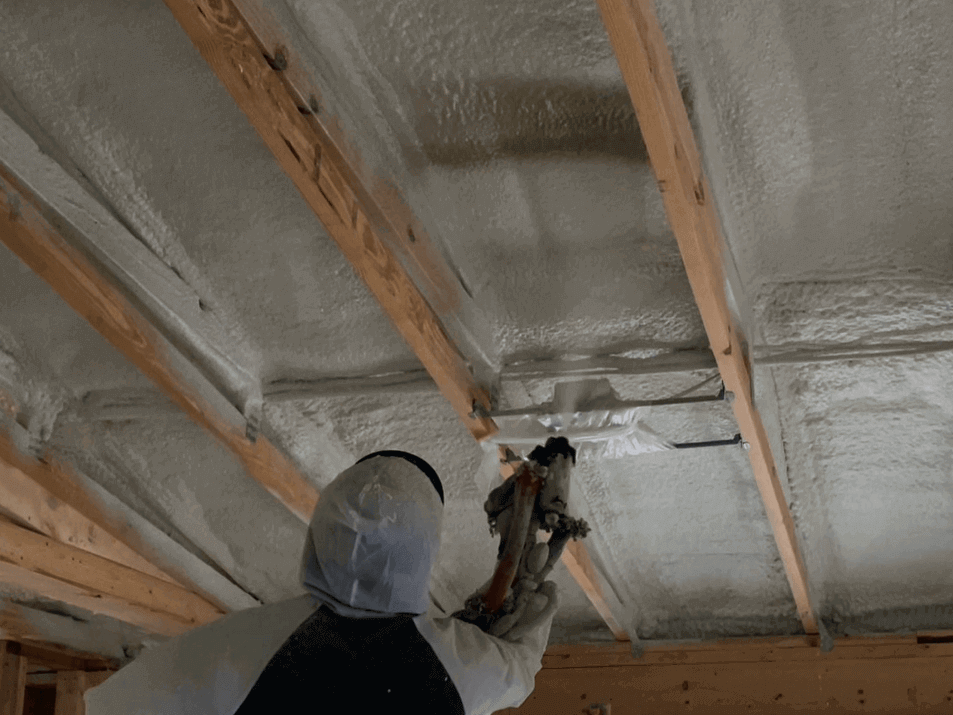
If you’re researching spray foam insulation, you probably have a lot of questions. How long does spray foam last? What kind of R-value does spray foam offer? Why can closed cell spray foam be installed in basements, while open cell spray foam can’t? Why does spray foam seem to change color in videos of it being sprayed?
South Central Services has insulated hundreds of homes with spray foam insulation. We are happy to answer any questions about spray foam. As the experts, we break down how and why spray foam works.
By the time you’ve finished reading this article, you’ll understand why spray foam changes color during manufacturing and if it impacts your finished product.
Don't have time to read right now? Check out everything you need to know at a glance.
Spray Foam Is Created Through A Chemical Reaction.
When you hire a professional contractor to install spray foam for a project, you hire them for their expertise and equipment. The spray foam rig rolls up to your driveway, but the finished spray foam isn’t inside the rig. The rig holds the equipment and components to create spray foam.
Spray foam insulation is created through an exothermic chemical reaction. Spray foam creates heat and off-gassing fumes as a byproduct, with the product of the reaction being foam. To make a stable foam, variables like temperature, pressure, and ratio must be monitored and maintained.

Before Spraying, Spray Foam Components Look Similar To Motor Oil.
So, what do spray foam components look like? It depends on the manufacturer of the foam, but as a general rule, the liquid in spray foam drums looks a lot like motor oil.

When these two chemical components are portioned, heated, atomized, and mixed, a color change also occurs.
The Chemical Reaction Goes Through Several Stages.
There are two chemical reaction stages where you can see color changes. These color changes are observable evidence of the chemical reaction taking place.
If you sat down with a professional contractor, they could explain the industry terminology associated with these two stages: cream time and rise time.
Let’s examine the chemical reaction and color change of these stages in more detail.
During Cream Time, Components Meet And Appear Tan.
Cream time refers to when the foam components go from a liquid state to a solid state. The liquid chemicals contained in the spray foam drums have been portioned, heated, and atomized. Once they mix at the tip of the spray gun and are applied to a substrate, the chemicals are no longer liquid.
During the cream time, the color of the foam is no longer comparable to motor oil. Instead, the product looks more yellow or tan for the foams we use.
This flash of color happens for only a moment before the next stage of the chemical reaction takes place.
During Rise Time, Foam Rises And Changes Color.
Rise time happens almost immediately after spraying the foam. The expansion of the foam is almost instantaneous.
During rise time, the foam changes color again as it rises. For the foams we use at South Central Services, this color change is a movement from a yellowish-brown color to a creamy-white color.
Rise time is the period when foam expands and cures.
Foam Color Depends On Manufacturer Ingredients And Design.
You may have seen more exciting foam colors online. Purples, greens, and blues are all examples of foam colors on the market. Why are these foams colorful, while some foams are more white or yellow?

The color of the foam comes down to the manufacturer and the foam ingredients. Colorful foams are dyed to appear that color. A different color of foam doesn’t indicate any particular performance or R-value.
The natural color of foam is cream. Some foams are more white, while others are more yellow. The hue depends on the manufacturer.
Most Spray Foam Color Changes Are Normal And Expected.
All of the color changes we’ve outlined so far happen during the installation process. These natural color changes would only be seen by the contractor, unless they share footage online and someone picks up on the subtle differences. But what about spray foam color changes after installation?
Most spray foam color changes are normal and expected. Spray foam insulation does tend to yellow over time, especially when exposed to sunlight.

In rare cases, a color change can indicate off-ratio foam. Foam that is splotchy and extremely inconsistent in color can be an indicator. However, off-ratio foam is not something a homeowner can diagnose independently. If you are worried about the color of your foam after checking for odor and tackiness, contact a professional.
The Bottom Line About Why Spray Foam Changes Color
Because spray foam is created through a chemical reaction, it does experience some natural color changes during manufacturing. Liquid components start quite dark but turn much lighter in the transformation from liquid to solid. As foam rises, it changes color again, settling on its final color.
If the foam is coated or covered to protect it from UV ray exposure, it should not yellow significantly over time.
If spray foam has experienced significant color change that presents as splotchy or extremely inconsistent in color, call a professional contractor for a foam diagnosis. There is a chance that color inconsistency is an indicator of off-ratio foam.
Now that you know why spray foam changes color during manufacturing, your next step is to:
- Find out how long spray foam insulation is supposed to last
- Discover if spray foam can really make a home more comfortable
Disclaimer: While we strive to publish information accurate to building science, local building codes and standards supersede our recommendations.
Kilian has co-owned and operated South Central Services for 8 years. He is passionate about community involvement. In his spare time, he enjoys being with his family, playing ice hockey, and going fishing with friends.
Topics:


